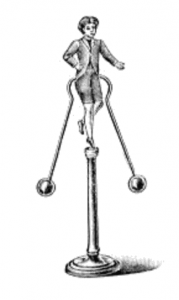Homeostasis is the term used in biology for the state of equilibrium achieved by an organism (or a wider system) in relation to its environment (or wider system). This state of equilibrium may require constant adjustments to be maintained as the environment changes. A strong case can be made for continuity between the concept of homeostasis and that of the Middle Way, whereby the Middle Way can be seen as a conscious homeostatic adjustment by those practising it.
Homeostasis for an organism involve striking a balance between over-stimulation and under-stimulation. For example, if a creature seeks food too actively at a time when there is none available, it will run out of energy and die. In a time of dearth it is better for it to conserve its energy, as hibernating animals do. On the other hand, if the same creature is too inactive at a time when food is freely available, it will take insufficient advantage of this situation and be out-competed by other animals. In evolutionary terms, then, gaining a point of equilibrium in which there is an optimal response to conditions is highly advantageous.
The Middle Way should not be reduced to an evolutionary ethic, and the idea of addressing conditions is not just a matter of evolutionary fitness for humans. However, evolutionary fitness based on homeostasis is probably the main way that animals practise a kind of proto Middle Way. The extremes of response to the environment to be avoided can be seen as based on implicit beliefs. These beliefs are inadequate because they are absolute and inflexible, and involve the animal acting under an implicit delusion as to the best way for it to interact with its environment. In other words, insofar as the animal gains homeostasis it is avoiding implicit metaphysical beliefs and following an implicit Middle Way.
The difference for humans (or other self-conscious beings, if they exist) is that the Middle Way can become a conscious object of reflection, and a principle used for explicit reasoning. When used in this way, the Middle Way becomes a balanced approach to whatever conditions we encounter. However easy or difficult are the conditions we find ourselves in, this explicit Middle Way can be applied, even if we are a very long way from the equilibrium involved in homeostasis or the implicit Middle Way. For example, even a man just emerging from an alcoholic stupor might have a brief dawning of reflective awareness, which he could invest so as to try to increase that awareness and get back a bit closer to the reflective equilibrium that he has lost in his drinking binge. He could reflect on the importance of rehydration for a brain recovering from alcohol, drink lots of water, and thus start to address conditions better. As an organism in terms of homeostasis, and judged in terms of fitness or adaptation to his environment, this man could be seen as seriously failing. However, he can still practice the Middle Way however far he is from homeostasis.
The concept of homeostasis can also be applied to groups of organisms, and to organic or even non-organic systems. James Lovelock famously applied it in his Gaia Hypothesis, inspired by observation of the equilibrium created between micro-organisms in the oceans and the chemical composition of the atmosphere. Lovelock then went on to demonstrate the workings of this homeostatic system in his Daisyworld model. This model shows that even for large, complex systems, equilibrium can be achieved by a process of adjustment, and does not require belief in the capacity of unreflective organisms to plan ahead in relation to goals.
However, when dealing with complex groups of reflective organisms like humans, it is reasonable to talk in terms of the explicit Middle Way as well as in terms of implicit homeostasis. Homeostasis for human society in relation to our environment would require a much more sustainable use of resources than the one we have now, and this in turn would require something closer to homeostasis amongst more individuals. However, the Middle Way involves a rebalancing from where we are now, so the political application of the Middle Way does not involve a doomed and discontinuous attempt to jump to an ideal state of homeostasis. Attachment to this idealisation is another sort of maladaptive metaphysics. Rather, it involves a self-conscious rebalancing process both at individual and social level. As a global society, our position is much more like that of the man emerging from an alcoholic stupor than one of ‘natural’ homeostasis.

Utterly delightful little essay! Daisyworld and alcohol abuse employed on philosophical enlightenment. Never seen before.